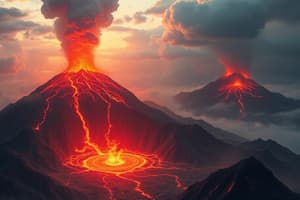Podcast
Questions and Answers
What is an earthquake?
What is an earthquake?
- A sudden release of energy causing vibrations in the Earth (correct)
- A type of volcanic eruption
- A weather phenomenon
- A large tsunami
What is the focus of an earthquake?
What is the focus of an earthquake?
The point within Earth where an earthquake originates.
What are faults?
What are faults?
A fracture in Earth along which movement has occurred.
Explain elastic rebound in the context of earthquakes.
Explain elastic rebound in the context of earthquakes.
What is an aftershock?
What is an aftershock?
What is a foreshock?
What is a foreshock?
What is fault creep?
What is fault creep?
Define seismology.
Define seismology.
What is a seismograph?
What is a seismograph?
Explain what a seismogram is.
Explain what a seismogram is.
What are surface waves?
What are surface waves?
What are body waves?
What are body waves?
What are Primary (P) waves?
What are Primary (P) waves?
What are Secondary (S) waves?
What are Secondary (S) waves?
What is the epicenter of an earthquake?
What is the epicenter of an earthquake?
What is the Circum-Pacific Belt?
What is the Circum-Pacific Belt?
Define intensity in the context of earthquakes.
Define intensity in the context of earthquakes.
What does magnitude mean in terms of earthquakes?
What does magnitude mean in terms of earthquakes?
Explain the Modified Mercalli Intensity Scale.
Explain the Modified Mercalli Intensity Scale.
What is the Richter scale?
What is the Richter scale?
What is the Moment Magnitude Scale?
What is the Moment Magnitude Scale?
What is liquefaction?
What is liquefaction?
What are seismic sea waves (tsunami)?
What are seismic sea waves (tsunami)?
What is the crust of the Earth?
What is the crust of the Earth?
Define the mantle.
Define the mantle.
What is the lithosphere?
What is the lithosphere?
What is the asthenosphere?
What is the asthenosphere?
What is the lower mantle?
What is the lower mantle?
What is the core of the Earth?
What is the core of the Earth?
What is the outer core?
What is the outer core?
What is the inner core?
What is the inner core?
What is the Moho?
What is the Moho?
What are refracted waves?
What are refracted waves?
What is a shadow zone?
What is a shadow zone?
Flashcards are hidden until you start studying
Study Notes
Earthquake Concepts
- Earthquake: A vibration of Earth from the rapid release of energy.
- Focus: The origin point of an earthquake beneath the Earth's surface.
- Faults: Fractures in Earth where movement has occurred.
Seismic Mechanics
- Elastic Rebound: Rocks deform and, upon breaking, release stored energy leading to an earthquake’s vibrations.
- Aftershock: A smaller earthquake that occurs following the main earthquake event.
- Foreshock: A smaller earthquake that typically occurs before a more significant earthquake.
Seismology and Measurement
- Seismology: The scientific study of earthquakes and seismic waves.
- Seismograph: An instrument used to record the vibrations produced by seismic waves.
- Seismogram: The output or the record generated by a seismograph.
Types of Seismic Waves
- Surface Waves: Seismic waves that travel along Earth’s surface, often causing the most damage.
- Body Waves: Seismic waves that move through the Earth's interior.
- Primary (P) Waves: Compression waves that push and pull rocks in line with their direction.
- Secondary (S) Waves: Waves that cause particles to shake perpendicular to their direction of travel.
Earthquake Location and Impact
- Epicenter: The surface point directly above the earthquake's focus.
- Circum-Pacific Belt: The major zone where most earthquakes occur globally.
- Intensity: A measure of shaking at a specific location based on damage.
- Magnitude: The total energy released during an earthquake.
Measurement Scales
- Modified Mercalli Intensity Scale: Rates shaking and damage variances across locations.
- Richter Scale: A logarithmic scale from 1 to 10 used to quantify earthquake energy release.
- Moment Magnitude Scale: A more precise measure based on fault displacement and energy estimation.
Geological Effects
- Liquefaction: A phenomenon where shaking causes wet soil to act like a liquid.
- Seismic Sea Waves (Tsunami): Water waves generated by seismic events, volcanic activity, or landslides.
Earth Layers
- Crust: The thin outer layer of Earth.
- Mantle: The rocky layer beneath the crust, approximately 2900 kilometers thick.
- Lithosphere: The cool and rigid layer that includes the crust and uppermost mantle.
- Asthenosphere: The soft layer under the lithosphere where lithospheric plates move.
Core Structure
- Lower Mantle (Mesosphere): Rigid and brittle layer constituting 80% of Earth’s material, located between 670-2900 km depth.
- Core: The central part of Earth made up of iron and nickel.
- Outer Core: A liquid layer within the core, characterized by mobile properties.
- Inner Core: A solid metallic sphere made primarily of nickel and iron.
Geophysical Boundaries
- Moho: The boundary separating the crust from the mantle.
- Refracted Waves: Waves in shallow water that slow down, bend, and align with underwater contours.
- Shadow Zone: An area between 105 and 140 degrees from an earthquake epicenter where direct P waves are absent due to refraction through the Earth's core.
Studying That Suits You
Use AI to generate personalized quizzes and flashcards to suit your learning preferences.




